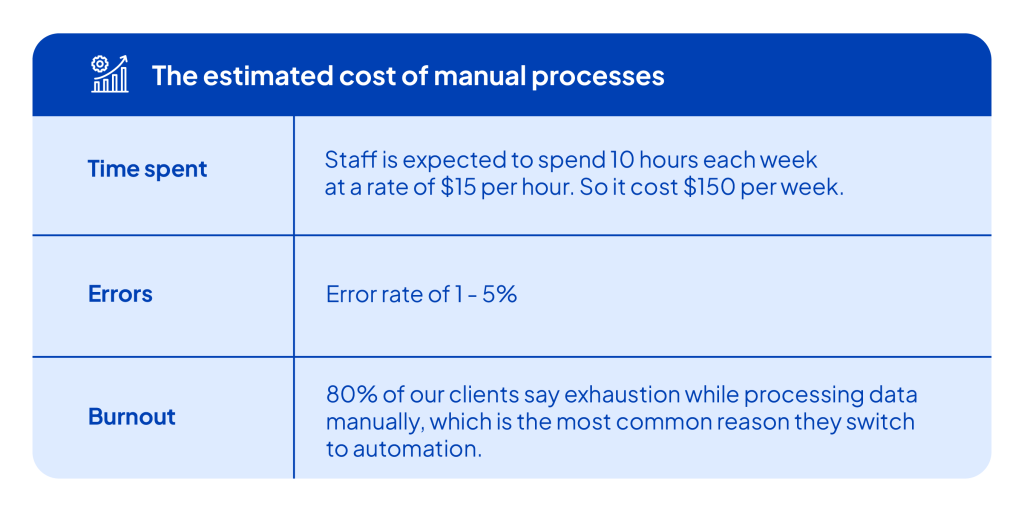Manual data entry is the process of entering data from documents into a system that a business uses one by one. This obviously takes time, particularly when a business has a large number of documents. Imagine employees have to spend a whole day just entering data; this could be overwhelming for staff, resulting in delayed tasks. has been shown to be inefficient, it is still used in many business industries today. They could be small businesses that believe that using automation requires them to pay much for software, which increases their costs. So they choose to rely on manuals, even though trying to process documents has so many negative impacts.
In this article we will go over why manual data entry is bad for your business, including the true cost of manual data entry and the best strategy to achieve efficiency.
The Unnoticed Cost of Manual Data Entry
The true cost of manual data entry is sometimes hidden; people simply assume it is cheaper than automation. Here are various costs that businesses incur for manual:
- Time drained : Employees spent hours inputting data, with an estimated 10 hours each week.
- Human error : Manual processes generate error rates around 1-5%. Errors such as typos in dates, names, or numbers and miscalculations can have a major effect on the overall process.
- Low productivity : The manual method requires employees to handle repetitive tasks that take a long time, which increases burnout and reduces staff satisfaction and engagement.
By breaking it down, we can estimate the average costs businesses face for manual data entry, as summarised in the table below:

Business Risk You Can’t Ignore Through Manual Data Entry
There are several risks that may frequently arise when businesses continue to rely on manual processes, such as:
Compliance and Accuracy Problems
Manually is prone to errors, leading to accuracy issues that can impact compliance regulations such as tax filling, fines, and audit. It also can damage the company’s reputation.
Delayed Decision-Making
Since manual work takes a long time, it can slow down workflow and result in a delay in decision-making, which delays approval. This will have an effect both on internal operations and external relationships, such as with stakeholders.
Scalability Issues
Manual processes rely on human effort, which lacks the ability to handle large volumes of documents fast. This poses scalability challenges for businesses that use manual processes, particularly when dealing with a lot of documents.
The Best Way: Automation and Advanced Technology
Automation using advanced technology is the best solution to tackle the challenge caused by manual data entry. With its capabilities and benefits, most businesses are shifting away from manual processes and seeing significant improvements in workflow. As shown in our previous estimate, the true cost of manual methods is high, often more expensive than automation.
When it comes to automation, choosing the right software with powerful features and affordable pricing can be difficult. That is where Fintelite AI comes in.
Fintelite contains advanced technology that evolves with current market trends. It not only speeds up data entry processes but also keeps businesses aligned with market trends. With 10x faster data processing and over 90% accuracy, tasks that used to take days can now be completed in minutes. It also can detect any potential fraud in documents quickly, eliminating the need for multiple checks by staff and reducing the risk of negative impact. This significantly saves time and enhances staff satisfaction, which boosts overall productivity.
Fintelite can cater to business-specific needs, providing affordable pricing with full benefits without compromising features and security.



